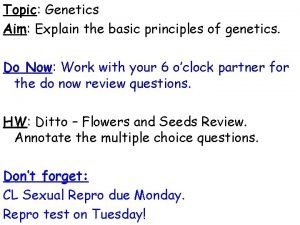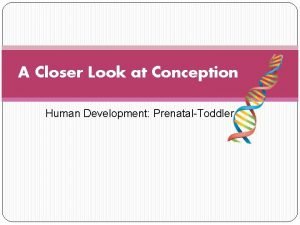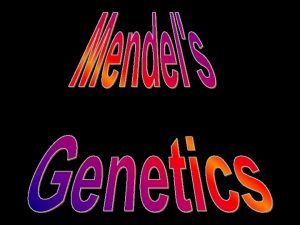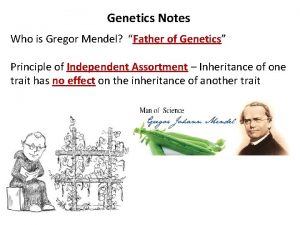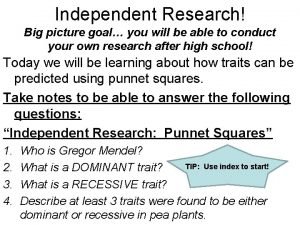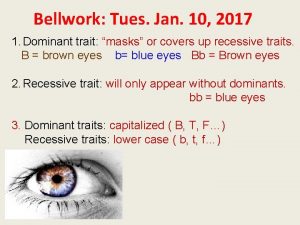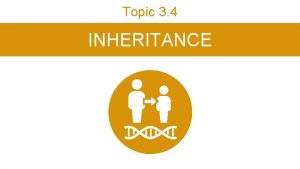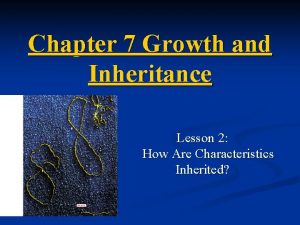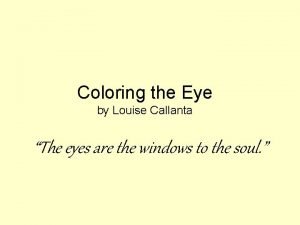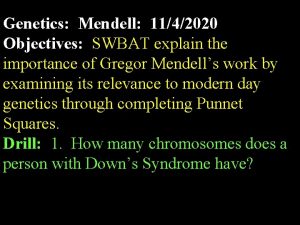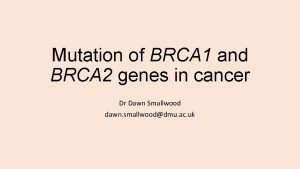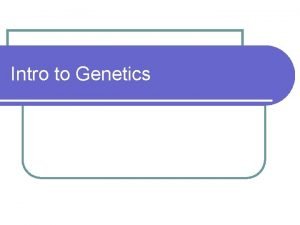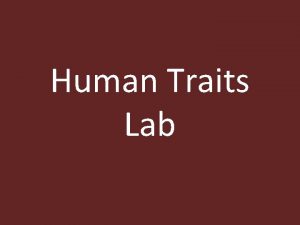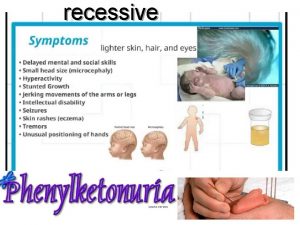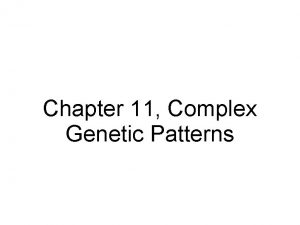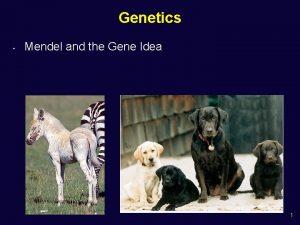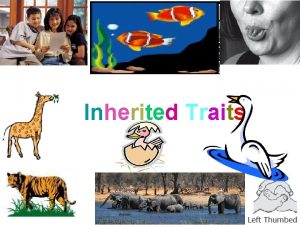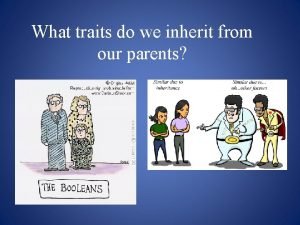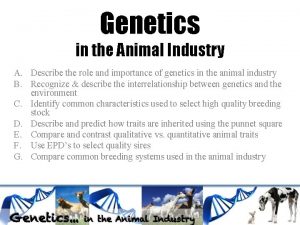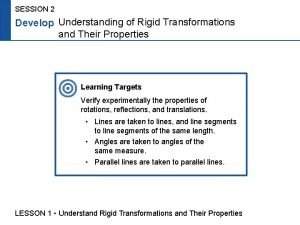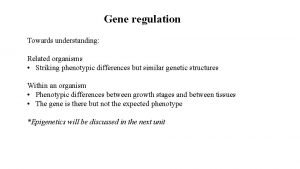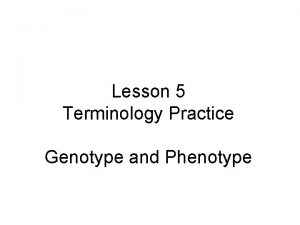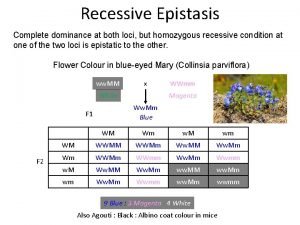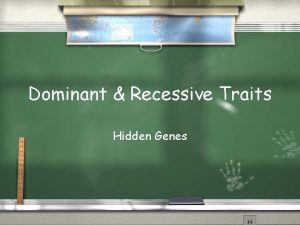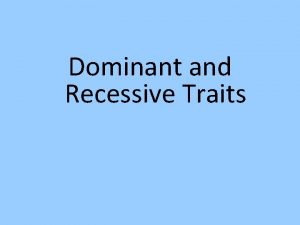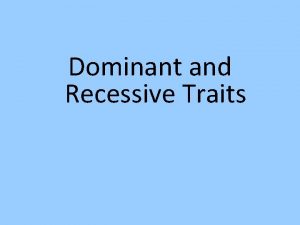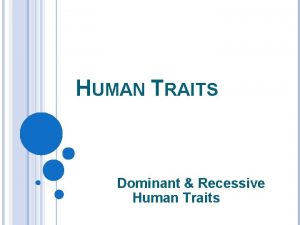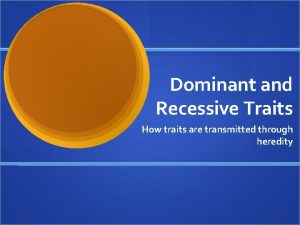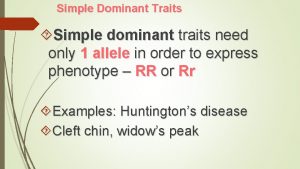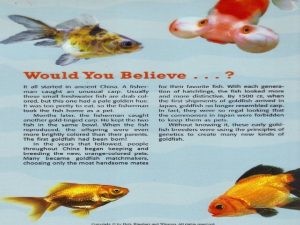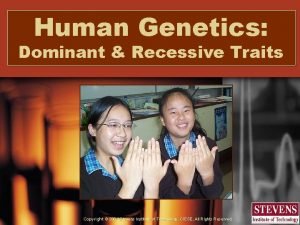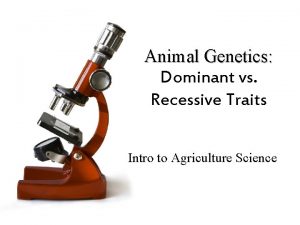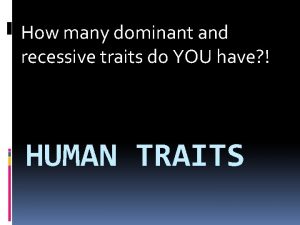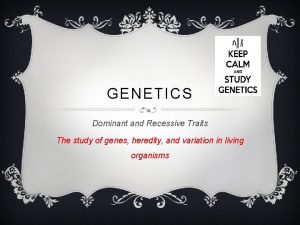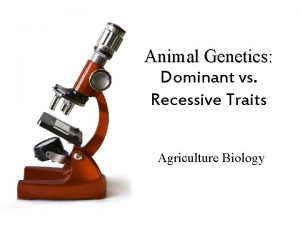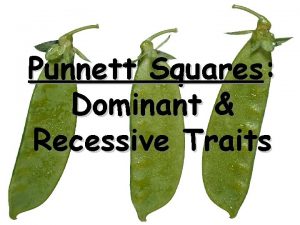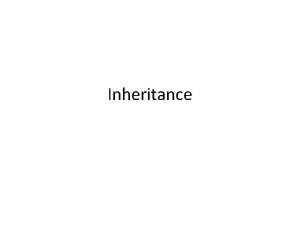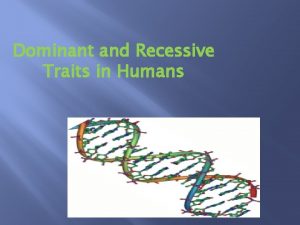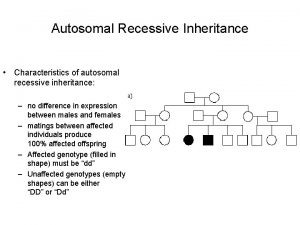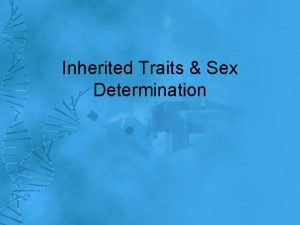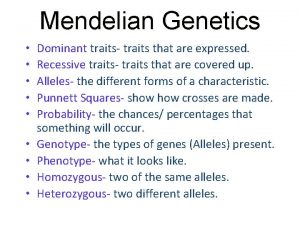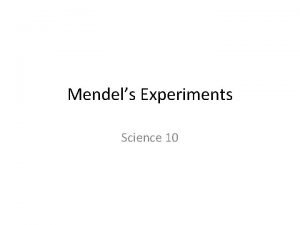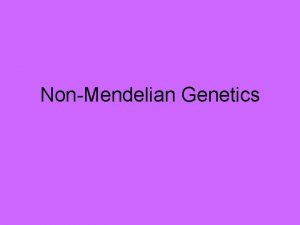Figure 9 8 A Dominant Traits Recessive Traits











































- Slides: 43

Figure 9. 8 A Dominant Traits Recessive Traits Freckles No freckles Widow’s peak Straight hairline Free earlobe Attached earlobe

Table 9. 9

Variations of Mendelian Genetics 5. 5 and 5. 6






Dihybrid Cross • Looks at two pairs of contrasting traits at the same time

Dihybrid Cross Example • Round or wrinkled and green or yellow • Law of segregation still applies 4 different alleles, 9 possible genotypes, 4 possible phenotypes

Independent Assortment • The inheritance of an allele for one characteristic does not affect the inheritance of an allele for a different characteristic. • Related to independent orientation during meiosishomologous chromosomes randomly line up on the left and right side. • Independent assortment still applies even if the alleles for the different characteristics are on the same chromosome because of crossing over which occurs during prophase I of meiosis


Law of Segregation vs. Law of Independent Assortment • Law of segregation is talking about how haploid gametes are produced through the process of meiosis • Law of independent assortment is talking about how the inheritance of one characteristic does not effect the inheritance of other characteristics

Complete Dominance Pea Plant Genotype Phenotype Homozygous dominant (PP) Purple Heterozygous (Pp) Purple Homozygous recessive (pp) White 2 different alleles, 3 possible genotypes, 2 possible phenotypes


Incomplete Dominance • Neither allele is purely dominant or recessive • The phenotype of the heterozygote is a result of both alleles being expressed • Results in an intermediate phenotype

Incomplete Dominance Example • Many common garden flowers like the snapdragon have genes for flower color that display incomplete dominance.

Incomplete Dominance Snapdragon Genotype Phenotype Homozygous for red (RR) Red Heterozygous (RW) Pink Homozygous for white (WW) White 2 different alleles, 3 possible genotypes, 3 possible phenotypes

Incomplete Dominance Hypercholesterolemia One example of incomplete dominance in humans is hypercholesterolemia, in which • dangerously high levels of cholesterol occur in the blood and • heterozygotes have intermediately high cholesterol levels.

Figure 9. 11 B HH Homozygous for ability to make LDL receptors Genotypes Hh Heterozygous hh Homozygous for inability to make LDL receptors Phenotypes LDL receptor Cell Normal Mild disease Severe disease

Co-dominance • Neither allele is purely dominant or recessive • The phenotype of the heterozygote is a result of both alleles being expressed • Does not result in a blend or intermediate characteristics • Both alleles are expressed separately and equally

Co-dominance Example • Many mammals have genes for hair color that display co-dominance

Co-dominance Horse Hair Genotype Phenotype Homozygous for red (RR) Red Heterozygous (RW) Roan Homozygous for white (WW) White 2 different alleles, 3 possible genotypes, 3 possible phenotypes

Multiple Alleles • In each example we’ve looked at so far, the trait is a result of the interaction of 2 different alleles. • With many traits, however, there are more than 2 possible alleles that you could inherit.

Multiple Alleles Example • There are 3 possible alleles for blood type and they display a combination of complete dominance and co-dominance. • Allele for blood type A and B are both dominant over the allele for blood type O • Allele for blood type A and B are co-dominant

Multiple Alleles ABO Blood Type • There are three possible alleles: IA, IB, and i. • The combination of two of those alleles determines an individuals blood type. Blood Types (Phenotypes) Possible Genotypes Type A IAIA or IAi Type B IBIB or IBi Type AB IAIB Type O ii

Multiple Alleles ABO Blood Type 3 different alleles, 6 possible genotypes, 4 possible phenotypes

Polygenic Inheritance (Multiple Genes) • Multiple genes at different loci and/or on different chromosomes effect a single characteristic • Most human traits have some degree of polygenic inheritance • Skin color, hair color, eye color, height, body build, intelligence…

Polygenic Inheritance (Multiple Genes) Example • There is at least 3 genes that control skin color • Combinations result in a blend from very light to very dark • Behavior and the environment play an important role as well

Polygenic Inheritance (Multiple Genes) Skin Color 6 different alleles, 27 possible genotypes, 7 possible phenotypes

Sex Determination • Humans have 46 chromosomes (23 pairs) • 22 pairs of autosomes and one pair of sex chromosomes • Sex chromosomes determine the sex and we represent them with an X and a Y. • Female = XX • Males = XY • It is the man’s gene that determines the sex of the child

Sex-Linked Traits • X chromosome is much larger than the Y chromosome • Genes on the X chromosome are important for both males and females • Genes on the Y chromosome are what make a male • In females characteristics are determined by the interaction of the alleles on each X chromosome • In males, since they only have one X chromosome and the Y chromosome is much smaller, some characteristics are determined by a single allele on the X chromosome.

Sex-Linked Traits Example • Red-green colorblindness • Reduced amount of a chemical in the retina of their eyes • Red-green colorblindness is a recessive characteristic that is found on the X chromosome

Sex-Linked Trait Red-Green Colorblindness Male Genotype Phenotype N Normal n Colorblind X Y XY

Sex-Linked Trait Red-Green Colorblindness Female Genotype Phenotype XN XN Normal XN X n Normal Xn Xn Colorblind Carrier- a carrier for an X-linked trait is a female individual who does not exhibit the characteristic but does carry the gene for the trait

Sex-Linked Trait • Colorblind father x Heterozygous mother • Father with normal vision x Heterozygous mother • Colorblind father x Homozygous mother with normal vision • Father with normal vision x Colorblind mother

Pedigree • Chart that geneticists use to trace the presence or absence of a trait in a number of generations • Square = male • Circle = female • Shaded = has trait • Not shaded = does not have trait

Hemophilia • X-linked recessive trait • “Bleeder’s disease” • Hemophilia- genetic disorder that causes individuals to lack an enzyme in the blood that is essential for normal blood clotting • Normally minor cuts, bruises, and scrapes can become very serious • In the past, individuals with this disorder typically died very young • Modern medication can replace the enzyme

Pedigree




 X linked recessive vs autosomal recessive pedigree
X linked recessive vs autosomal recessive pedigree Is curly hair dominant
Is curly hair dominant Blood punnet square
Blood punnet square Blue eyes genetics
Blue eyes genetics Dominant and recessive genes
Dominant and recessive genes Punnet square
Punnet square Punnett square for color blindness
Punnett square for color blindness Is hitchhiker's thumb dominant or recessive
Is hitchhiker's thumb dominant or recessive Autosomal dominant vs autosomal recessive
Autosomal dominant vs autosomal recessive Dominant and recessive genes
Dominant and recessive genes Punnett square calculator
Punnett square calculator Sex linked traits pedigree
Sex linked traits pedigree Free earlobe vs attached
Free earlobe vs attached Are dimples dominant or recessive
Are dimples dominant or recessive Are thin lips dominant or recessive
Are thin lips dominant or recessive Dominant and recessive genes
Dominant and recessive genes Roll tongue genetic
Roll tongue genetic Punnett square eye color hazel
Punnett square eye color hazel Heterozygous dominant
Heterozygous dominant Is brca dominant or recessive
Is brca dominant or recessive Free earlobes dominant or recessive
Free earlobes dominant or recessive Are dimples dominant or recessive
Are dimples dominant or recessive Pku is autosomal or sexlinked
Pku is autosomal or sexlinked Widow's peak is dominant to no widow's peak
Widow's peak is dominant to no widow's peak Dominant vs recessive genetic disorders
Dominant vs recessive genetic disorders Dominant or recessive
Dominant or recessive Is down syndrome dominant or recessive
Is down syndrome dominant or recessive Elephant inherited traits
Elephant inherited traits Are dimples recessive
Are dimples recessive Qualitative traits vs quantitative traits
Qualitative traits vs quantitative traits Inheritance of quantitative traits
Inheritance of quantitative traits Qualitative traits vs quantitative traits
Qualitative traits vs quantitative traits Understand rigid transformations
Understand rigid transformations Washing machine solid or plane figure
Washing machine solid or plane figure Identify the type of congruence transformation
Identify the type of congruence transformation How to do 6 figure grid references
How to do 6 figure grid references Autosomal recessive cystic fibrosis
Autosomal recessive cystic fibrosis Sex determination and sex linkage
Sex determination and sex linkage Duplicate recessive epistasis
Duplicate recessive epistasis What is interphase
What is interphase Homozygous recessive
Homozygous recessive Phenotype
Phenotype Duplicate recessive epistasis
Duplicate recessive epistasis Sex linkage punnett square
Sex linkage punnett square



